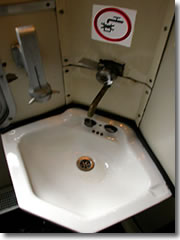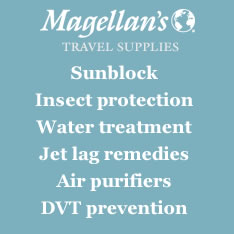Can I drink the water?
Is the water safe to drink in Europe? How about Mexico? Asia?
• Why you can't drink the water
• Drinking safely
• Treating water 
In destinations where it is generally safe to drink the water, those few place where you should not (like on this European train) will often tell you via pictogram. Generally, you can drink the water in Europe (except on trains), North America (except Mexico and some of the less developed Caribbean islands), and Oceania (Australia and New Zealand).
In these destiantions, if a water source ever isn't safe, there will be a fairly obvious sign (eau non potable, acqua non potabile, keine trinkwasser) and/or a pictogram of a glass with a slash or X across it.
Anywhere else in the world—Asia, Africa, South America(or if you're hiking in the backwoods even in the developed world)—stick to bottled water or treat any tap water or creek water with a sterlizing filter.
Technically, the water is usually pretty safe in most major cities of these continents (Hong Kong, Tokyo, Singapore, Buenos Aires, Santiago, Rio, Cairo, Cape Town, etc.). However, I have run across even hotels in Hong Kong with signs warning that the tap water isn't safe for drinking.
Again, it's wisest just to stick to bottled water—and certainly anywhere outside a major city or resort where they advertize the water has been treated.
Why shouldn't I drink the water?
Sometimes the local water contains actual disease. In most cases, it simply contains bacteria or microbes to which your digestive system is not accustomed. It doesn't affect locals, but foreigners get la turista.
In the case of diseases, however, the results can be much more dramatic—and more dangerous.
How to drink water safely
Take it from someone who did drink the water in Mexico and (barely) lived to tell the tale—and who has suffered crypto, giardia, and the Norwalk virus (all of which entail days of torturous diarrheal anguish for the hale and hearty, potential death for the frail).
Outside of Europe and USA/Canada (where tap water is reliably safe—except on European trains), avoid waterborne illnesses with these tricks:
- Stick to bottled water whenever possible—including for brushing your teeth. Be sure the cap's seal is unbroken—some unscrupulous merchants refill empty bottles from the tap. I always order fizzy water so I can tell instantly whether it's truly fresh (if it's flat, it's been tampered with).
- Avoid ice cubes
- Hedge your bets by treating all tap water
How to treat water to kill the bugs
You have four options for water treatment offering various levels of protection against three categories of microscopic beasties: protozoa (Giardia, Cryptosporidium), bacteria (e. coli, salmonella, cholera), and viruses (hepatitis A, polio, Norwalk, rotavirus, etc.).
 Bottle with a built-in filter. Filters strain out impurities and catch protozoa (P) and bacteria (B)—but not viruses (V). Thee work fine for even backwoods travel in developed countries (I carry one for camping), but are less safe in developing countries where viruses are a concern.
Bottle with a built-in filter. Filters strain out impurities and catch protozoa (P) and bacteria (B)—but not viruses (V). Thee work fine for even backwoods travel in developed countries (I carry one for camping), but are less safe in developing countries where viruses are a concern. Bottle with a built-in purifier. Purifiers are basically a filter (handling P and B) with an added level of chemical cleansing to kill viruses. This is the most convenient method (I carry one for travel abroad). Downside: Can only treat one bottle at a time, as you sip from it.
Bottle with a built-in purifier. Purifiers are basically a filter (handling P and B) with an added level of chemical cleansing to kill viruses. This is the most convenient method (I carry one for travel abroad). Downside: Can only treat one bottle at a time, as you sip from it.  Sterilizer. This is a little UV wand you stick into any bottle or glass of water, push a button, and in just 30 seconds it kills all three types of nasties (P, B, V). This is by far the easiest method, and most versitile (can treat multiple bottles, or any sort, quickly). Downsides: it needs batteries, doesn't catch impurities, and won't work with really murky water. (I carry one, but also purification tablets as a backup—always afraid that UV lamp might break, though it never has.)
Sterilizer. This is a little UV wand you stick into any bottle or glass of water, push a button, and in just 30 seconds it kills all three types of nasties (P, B, V). This is by far the easiest method, and most versitile (can treat multiple bottles, or any sort, quickly). Downsides: it needs batteries, doesn't catch impurities, and won't work with really murky water. (I carry one, but also purification tablets as a backup—always afraid that UV lamp might break, though it never has.) Purification tablets. Drop one into your water, wait 30 minutes, and it kills everything (P, B, V)—though you're supposed to wait four hours to be sure it gets any crypto. Forget those old-school iodine tabs; Chlorine Dioxide works better and tastes... uh, well, less awful. Downside: You have to wait half an hour.
Purification tablets. Drop one into your water, wait 30 minutes, and it kills everything (P, B, V)—though you're supposed to wait four hours to be sure it gets any crypto. Forget those old-school iodine tabs; Chlorine Dioxide works better and tastes... uh, well, less awful. Downside: You have to wait half an hour.
Do drink water—just be sure it's safe first
Either carry an environmentally-friendly reusable bottle or buy disposable (but refillable!) water bottles as you go.
Either way, always carry water to stay hydrated—it helps maintain energy and keep you from getting sick.
Section Index |
Related Partners
|
This article was by Reid Bramblett and last updated in August 2011.
All information was accurate at the time.
Copyright © 1998–2013 by Reid Bramblett. Author: Reid Bramblett.


